[mashshare]

At one time a world altitude record was attained somewhere between Scott Field in Illinois and Sparta, TN. The experimental craft was state of the art, lightweight and massive. The solo pilot was considered one of our country’s top airmen. The craft took off at 2:23 in the afternoon, then crashed into trees just outside of Doyle at 5:20 PM the same day. Having traveled three-hundred miles in three hours and three minutes indicates an above-ground speed that sometimes exceeded 100 mph. The curiosity here is Hawthorne C. Gray’s cockpit was made of wicker – – yes, like lawn furniture; Captain Gray was piloting a balloon, the year was 1927.
Internet searches on Captain Gray reveal tomes of data. Both Popular Science and Popular Mechanics wrote of his demise. Some accounts say his body was discovered the following morning by a young man who climbed a tree to investigate a downed balloon. Others state that Captain Gray had thrown his oxygen container overboard to try and gain a little more altitude. But one, arcane publication credits Captain Grays death to a milestone. The conclusion was drawn, that at very high altitudes, the human body can’t process oxygen and his death led to the creation of pressurized air suits. Analog gauges on board recorded altitudes at specific times, from those records, it can be concluded that his touchdown was in fact at 5:20 PM and that the temperature in the basket dipped to seventy below during the flight. And he had flown over eight miles high, and averaged almost 100 miles per hour – – in a balloon!
Kudos to Captain Gray, a different kind of pioneer, who lost his life for his country and albeit sad, added more history to CragrockUSA.
[mashshare]
One of the original east-west routes in the United States took advantage of a natural “low gap” in the Cumberland Plateau escarpment. A few of the original inns along that route still stand, one is located just outside of Sparta TN and is known as the Rock House Historic Shrine. The seventh president of the United States, Andrew Jackson, purportedly used this inn for lodging as he made trips to and from Washington. The Rock House would have been four days from Nashville along that trail, Pleasant Hill, would be yet another day’s travel from here.

The Rock House Historic Shrine. To lend credence to the cliche “They don’t build them like they used to” 90% of the roof on this structure is original.
It is said that the wealthy took refuge in the Rock House, the poor sought shelter under the bluffs along the old road. If you look closely, you will still find hand-scrawled names and dates along these cliffs, some legible, some faded – – all tell part of a pioneer’s life story.
Eventually, the first paved road from the east to west coast carved it’s way through the same low gap as the Old Stage Road. This highway has been deemed the “Broadway of America”, and is still labeled as such on many maps. Spanning eight states and over 3,000 miles US 70 resulted in several cities being built along its path; they flourished until Interstate 40 was completed in the 1960’s. Sparta Tennessee was one of those sizeable towns with many mills, stores and the intersections of major east-west and north-south corridors. Sparta was nominated as the first capital of Tennessee, in fact, it lost by only one vote. Perhaps it is mere coincidence that the winner of that ballot, Nashville Tennessee, was later dubbed “The Athens of the South” – – and it lies about 90 miles from Sparta.

Look carefully for the scrawling in the center of the photo. Notice the use of “Script”. The date appears to be 1880.
[mashshare]